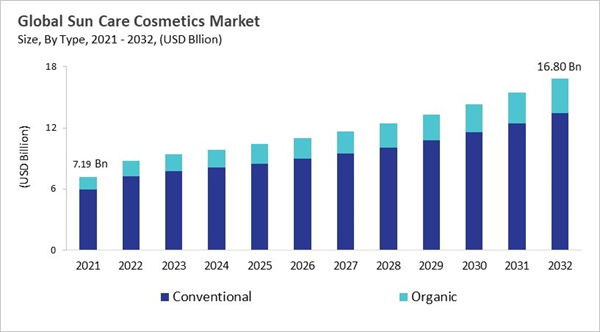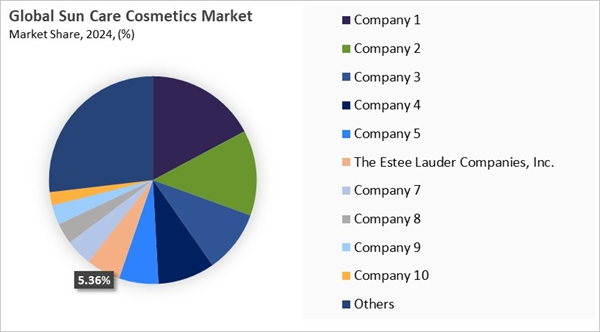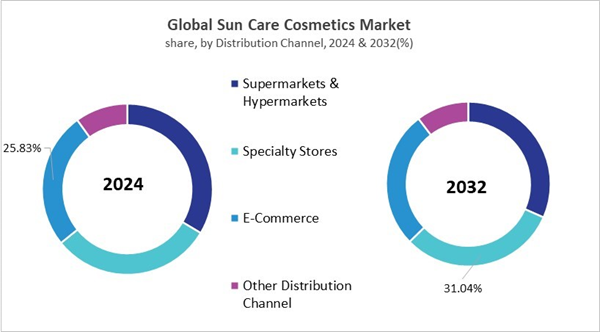Key Highlights:
- The Asia Pacific Sun Care Cosmetics market dominated the Global Market in 2024, accounting for a 34.15% revenue share in 2024.
- The China Sun Care Cosmetics market is expected to continue its dominance in North America region thereby reaching a market size of 1.77 billion by 2032.
- Among the various Product segments, the SPF Foundation dominated the global market contributing a revenue share of 22.71% in 2024.
- In terms of the distribution channel segmentation, the Supermarkets & Hypermarkets segment is projected to dominate the global market with the projected revenue share of 31.62% in 2032.
- Conventional led the type segments in 2024, capturing an 82.09% revenue share and is projected to continue its dominance during projected period.
The sun care cosmetics market has transformed from elementary physical sun barriers such as zinc oxide pastes to modern multipurpose products that combine skincare and sun protection. The launch of SPF in the mid-20th century and the growth of the chemical and mineral filters in the late 20th century boosted both the protective effectiveness and visual elegance of sunscreens, meanwhile regulatory frameworks improved consumer trust. In the 21st century, sunscreens are turned as basic, essential and fundamental skincare product. Companies are coming up with new formulas such as, lightweight textures anti-aging ingredients, and hybrid formats that serves as multifunction product. At the same time, inclusivity and aesthetics became very important. New products like tinted, transparent, and micronized mineral formulations were made to work with different skin tones and preferences. New textures and ways to deliver them, such as sticks, sprays, and powders, have made them useful in more than just beach settings.
Sustainability and environmental awareness have become major factors. Brands are changing their products to meet reef-safe standards, using packaging that can be recycled or refilled, and focusing on ethical sourcing. Top companies have focused on continuous product innovation, teaching consumers about their products, and making commitments to sustainability. This has made sunscreens an important part of health and beauty. They are also making products that work better in different climates and for different groups of people, adding more shades, and using a variety of distribution channels, such as e-commerce and retail partnerships. Because of these efforts, the sun care market has changed into a wellness-focused industry that is defined by being multifunctional, welcoming to everyone, and responsible for the environment. This will help it stay strong in the changing global beauty market.
COVID-19 Impact Analysis
The COVID-19 pandemic had a big effect on the global sun care cosmetics market. Lockdowns, travel bans, and the closing of beaches and resorts made people spend less time outside, which lowered the demand for sunscreen. Retail disruptions, such as long closures of duty-free shops and beauty stores, made it harder for people to shop and buy things on the spur of the moment. Tourism, which is a big reason why people buy sunscreen, fell apart, hurting both sales and brand visibility. People spend less on sunscreen every day because they work from home more. People who took care of their skin preferred moisturizing and taking care of themselves over protecting themselves from UV rays. Supply chain problems and delays in manufacturing also made it harder to find products, which hurt smaller brands the most. Thus, the COVID-19 pandemic had a negative impact on the market.Driving and Restraining Factors
Drivers
- Rising Global Awareness of Skin Health and Preventive Care
- Beauty Culture, Anti-Aging Trends, and Lifestyle Integration
- Innovation, Technology, and Product Diversification
- Expanding Distribution Networks and E-Commerce Growth
Restraints
- Seasonal Dependence and Limited Perception of Daily Use
- Safety Concerns, Ingredient Controversies, and Consumer Skepticism
- Regulatory Complexity and Market Saturation
Opportunities
- Rising Demand for Personalized and Tech-Enabled Sun Care Solutions
- Expansion of Sustainability and Eco-Friendly Innovation in Sun Care
- Growth Potential in Emerging Markets and Untapped Demographics
Challenges
- Global Regulatory Diversity and Constantly Evolving Standards
- Consumer Misinformation, Skepticism, and Trust Deficit
- Market Saturation and Price Competition Across Global Regions
Market Share Analysis
The leading players in the market are competing with diverse innovative offerings to remain competitive in the market. The above illustration shows the percentage of revenue shared by some of the leading companies in the market. The leading players of the market are adopting various strategies in order to cater demand coming from the different industries. The key developmental strategies in the market are Acquisitions, and Partnerships & Collaborations.
Type Outlook
Based on type, the sun care cosmetics market is characterized into conventional and organic. The organic segment attained 18% revenue share in the sun care cosmetics market in 2024. The organic sun care cosmetics segment has been gaining increasing traction as consumer awareness of health, safety, and sustainability rises. Products in this category emphasize natural or plant-derived ingredients, often marketed as eco-friendly, reef-safe, and free from synthetic additives or controversial chemicals. This segment has become especially attractive to consumers who prioritize holistic wellness and environmentally conscious lifestyles, as well as those with sensitive skin who seek gentle alternatives to traditional formulations.Distribution Channel Outlook
On the basis of distribution channel, the sun care cosmetics market is classified into supermarkets & hypermarkets, specialty stores, e-commerce, and others. The specialty stores segment recorded 31% revenue share in the sun care cosmetics market in 2024. The specialty stores segment serves as a key channel for consumers seeking premium, niche, or dermatologist-endorsed sun care cosmetics. These stores typically offer a curated selection of products, often with expert staff who provide personalized recommendations. Consumers shopping in specialty beauty and skincare stores are generally more informed, quality-conscious, and willing to spend on products that align with specific needs such as sensitive skin, anti-aging, or luxury formulations.Regional Outlook
Region-wise, the Sun Care Cosmetics Market is analyzed across North America, Europe, Asia Pacific, and LAMEA. The Asia Pacific segment gained 34% revenue share in the sun care cosmetics market in 2024. North America and Europe are two of the most developed and important areas in the world for sun care cosmetics. In North America, especially the US and Canada, demand is driven by a high level of consumer awareness about skin health, a strong dermatological influence, and growing worries about skin cancer and photoaging. People in this area also really like sunscreens that do more than just protect their skin, which fits with their health and beauty-focused lifestyles. On the other hand, Europe is shaped by its strict rules and cultural focus on sun safety. Countries like France, Germany, and the UK are at the forefront of innovation and adoption. The European market is also at the forefront of eco-friendly and sustainable sun care. This is because some UV filters are banned by law and there is a lot of demand from consumers for reef-safe and environmentally friendly products.Asia Pacific and LAMEA are becoming high-growth areas with active consumer bases. In Asia Pacific, markets like, Japan, China, South Korea, and Australia are growing because there is a lot of demand for lightweight, daily-use sunscreens that work well in humid climates and beauty routines that focus on skin tone evenness and anti-aging. The area is also at the forefront of product innovation, especially when it comes to textures like gels, essences, and sprays that meet the needs of a wide range of customers. In Saudi Arabia, LAMEA, the UAE, Brazil, and South Africa are all countries where opportunities are growing because people are making more money, becoming more aware of how the sun can hurt them, and spending more time outside. Brazil's beach culture and the Middle East's year-round sun exposure are two big reasons why people use sunscreen. In both areas, the combination of climate, lifestyle habits, and growing awareness keeps demand steady. There is also a growing shift toward inclusive shades, affordable products, and environmentally safe formulations.
List of Key Companies Profiled
- L'Oréal S.A.
- Beiersdorf AG
- Johnson & Johnson
- Unilever PLC
- Shiseido Company Limited
- The Estee Lauder Companies, Inc.
- Coty, Inc.
- Clarins Group SA
- Edgewell Personal Care
- The Procter & Gamble Company
Market Report Segmentation
By Type
- Conventional
- Organic
By Distribution Channel
- Supermarkets & Hypermarkets
- Specialty Stores
- E-Commerce
- Other Distribution Channel
By Product
- SPF Foundation
- SPF Sunscreen
- SPF Lotion
- SPF BB Creams
- SPF Spray
- Tinted Moisturizers
- SPF Primers
- Other Product
By Geography
- North America
- US
- Canada
- Mexico
- Rest of North America
- Europe
- Germany
- UK
- France
- Russia
- Spain
- Italy
- Rest of Europe
- Asia Pacific
- China
- Japan
- India
- South Korea
- Singapore
- Malaysia
- Rest of Asia Pacific
- LAMEA
- Brazil
- Argentina
- UAE
- Saudi Arabia
- South Africa
- Nigeria
- Rest of LAMEA
Table of Contents
Companies Mentioned
- L'Oréal S.A.
- Beiersdorf AG
- Johnson & Johnson
- Unilever PLC
- Shiseido Company Limited
- The Estee Lauder Companies, Inc.
- Coty, Inc.
- Clarins Group SA
- Edgewell Personal Care
- The Procter & Gamble Company











